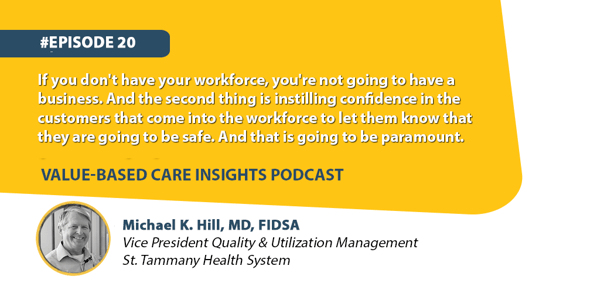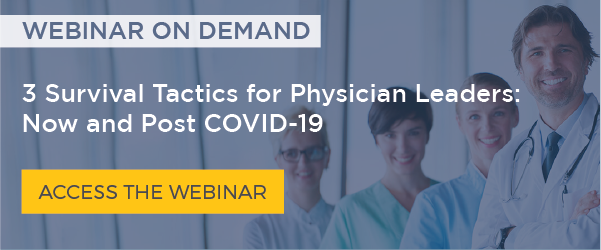Episode Overview:
As we move through the summer months, we’re seeing a potential spike in COVID-19 cases all over the country. In this episode, Daniel J. Marino and Shaillee J. Chopra talk to Dr. Michael Hill, MD, an infectious disease specialist, to understand the concerns hospital leaders must consider as the country enters the fall and winter seasons. Dr. Hill explains lessons learned from COVID from the spring season and how each lesson can help healthcare providers be more prepared to help combat COVID, a potential flu outbreak, and any other medical dilemmas that may operate in tandem.
Co-hosts:

Daniel J. Marino, Managing Partner, Lumina Health Partners

Shaillee Chopra, Principal, Lumina Health Partners
Guest:
 Dr. Michael Hill, MD, Infectious Disease Specialist, Chief Quality Officer, St. Tammany Parish Hospital
Dr. Michael Hill, MD, Infectious Disease Specialist, Chief Quality Officer, St. Tammany Parish Hospital
Episode Discussion Areas:
1. Groups impacted as a result of COVID
- Patients with non-COVID medical conditions
- Nursing homes and long-term care (LTC) facilities
- School systems
- Physicians and providers
- Employers
- Community and county influence
2. Collaborative opportunities to stop the spread
- How do we focus on keeping nursing homes and LTC facilities safe, given the vulnerable population (65 and older)?
- What should hospitals do to better align with LTC facilities?
- What are some strategic initiatives hospitals can take to align with communities or county health boards?
3. Hospitals' role as community leaders
- As hospitals provide testing, treatments, and COVID education programs, there’s an opportunity for hospitals to “build the bridge” and align with employers.
- Hospitals should see this as an opportunity to better connect with the community and employers, which will support their mission of patient care and create a stronger sense of trust.
- By connecting with the community, hospitals can instill a sense of confidence with patients.
- Hospitals can provide messaging, insights, and suggestions on how to protect patients and the community.
4. Keys to planning for the fall
- Hospitals must be proactive in managing the potential surge in COVID cases as well as treating non-COVID patients.
- Hospitals and medical leaders must align with the community and employers to offer information, programs, and medical leadership.
- Medical leaders should look at the data and models to anticipate a potential surge, keeping at the forefront the goal of protecting the most vulnerable cohorts of the population.
- Medical leaders must proactively manage the new realities of healthcare through partnerships with the community and employers, and through COVID related programs including testing.

9 Key Takeaways: Managing the COVID Surge From an Infectious Disease Perspective
- Is there a variation in how different age groups are reacting to COVID?
- There have been very few people under age 30 hospitalized at St. Tammany Parish Hospital, and it’s clear that respiratory failure is an issue for those older than 65. So with age, the number of comorbidities increase. And as a result, mortality, morbidity, and hospitalization rates grow.
- Many patients are also walking into the hospital with minimal symptoms.
- How is St. Tammany collaborating with nursing homes to manage the pressure?
- When we had our area’s first outbreak, we immediately started daily conversations with the nursing homes in the area, which included access to all infectious disease and pulmonary critical care experts. It’s important for us to get involved with the community, especially the most vulnerable populations, because they’re going to affect our hospital in a pandemic. Even today, we hold group and individual phone calls to address nursing homes’ concerns.
- Is the outbreak still considered a problem that hospitals need to solve?
- At the onset of the pandemic, there was a lot of pressure on hospitals to expand beds and quickly identify and treat patients. But really, if we’re going to succeed at managing COVID going forward, hospitals need to collaborate with the local board of health, nursing homes, and even schools to get in front of this issue.
- How can hospitals work with community members to prepare for surges?
- Hospitals must think about other groups that have particular challenges, like fire districts (where responders are cohabitating in small spaces) and school districts. We have to understand this is a fluid situation and new guidelines come out frequently, so we must be willing to adjust our plans and advice based on the evolving information.
- What are the biggest questions employers have about reacting to COVID?
- Of course, employers are concerned about how to help a COVID-positive employee. But employers also want to know how they can set up their offices to better protect their workforce. That includes cleaning and environmental preparation, but it’s also about keeping healthy employees healthy. Employers with a public-facing business (hospitals included) are also concerned about instilling confidence among their customers.
- How can facilities gain the confidence that will help them move forward?
- One strategy is updating the HVAC system with UV light and the right filters — or at least finding ways to add fresh air and ventilation. Health care organizations also want to be accessible, so we want businesses to be comfortable contacting us if they have questions about the changing guidelines or interpreting existing guidelines. Hospitals have the opportunity right now to take a leadership role in the community and inform residents how they manage COVID.
- How has COVID transformed the role of the hospital in communities?
- People are starting to appreciate that not only do they need hospitals, they also need hospitals to be flexible enough to take care of a surge of sick patients. Hospitals need to be thorough in their data-gathering and review, so they can develop the disease management strategies that work for the community in the near term. But hospitals also need to be transparent with their community and show what they’re doing to keep their patient population safe.
- What challenges are hospitals facing this fall and winter?
- Clearly, we’re anticipating a surge in COVID cases, the annual resurgence of the flu, and other respiratory diseases. One of the biggest challenges will be trying to diagnose a patient when so many of these respiratory diseases look the same. So, we’ll need rapid, reliable tests that will identify these diseases as they come in, but we’ll also want to stress the importance of earlier flu shots and self-isolation for anyone who is sick.
- What can hospitals do to take care of their providers?
- It’s going to be essential to take care of staff, because these times are tough — both mentally and physically. Hospitals should give providers time off, provide them a quiet room to get away from the hustle and bustle, and just encourage them to take time for themselves. If we’re going to get through this, we need to focus on the well-being of our workforce.
Learn how to support your physicians and healthcare leaders during the COVID-19 pandemic by watching our on-demand webinar, “3 Survival Tactics for Physician Leaders: Now and Post-COVID-19.”
About Value-Based Care Insights Podcast
Value-Based Care Insights is a podcast that explores how to optimize the performance of programs to meet the demands of an increasing value-based care payment environment. Hosted by Daniel J. Marino and Shaillee Chopra, the VBCI podcast highlights recognized experts in the field and within Lumina Health Partners.





Share this: